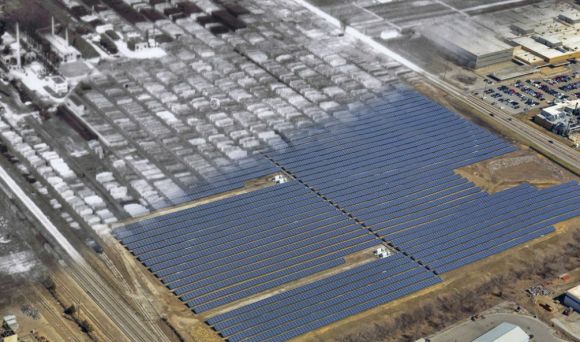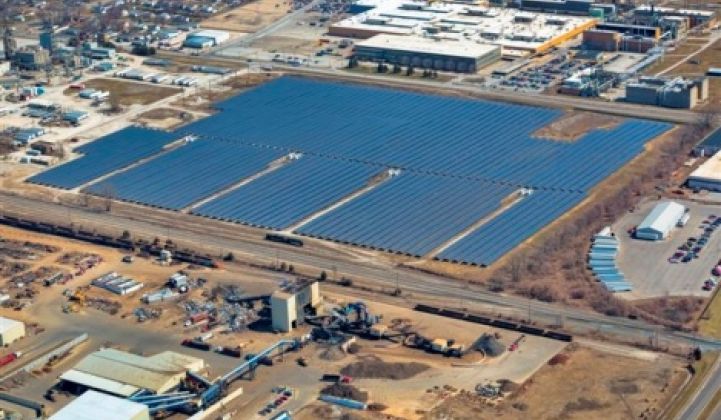Supported by the stimulus package and the Department of the Interior, developers continue to set records for the biggest solar and wind projects on untouched public lands.
For years, the Environmental Protection Agency has been waging its own less-known campaign to support projects on disturbed, polluted lands. And it now has a record-breaking project to claim.
Hanwha Q CELLS, a vertically integrated solar manufacturer and developer, has just completed a 10.8-megawatt solar PV project on a Superfund site in Indianapolis under EPA control. The Maywood Superfund project is the biggest on any EPA Superfund or brownfield site in the country.
According to the developer, it's not just the size that makes the installation unique -- it's the way it was constructed.
Hanwha Q CELLS said it was able to complete the project following EPA pollution-control guidelines without using any additional grants or incentives. The reason was a company-developed construction process that cut pollution risks, and thus, costs.
Starting in the 1950s, the 120-acre site was used for refining chemicals and treating wood products. According to the EPA, the soil is contaminated with benzene, ammonia, volatile organic compounds and carcinogenic tar deposits. While the land has been under some form of cleanup since 1994, the soil is still a threat to drinking water for the 5,200 people who live within 3 miles of the site.
Understanding the threat and cost to disturbing the ground, Hanwha Q CELLS said it developed a technique that reduced the amount of soil moved by 93 percent during the construction process. That allowed it to complete the project at "market costs" without added subsidies from the EPA, and to sell the power to Indianapolis Power & Light at a competitive price -- all while minimizing any risk to groundwater.
"In completing a non-subsidized Superfund project, Hanwha Q CELLS has broken a barrier that has frustrated solar project developers for more than 20 years. We are looking forward to future, similar projects,” said Charles Kim, CEO of Hanwha Q CELLS, in a statement.

A before-and-after picture of the Maywood Superfund project. Credit: Hanwha Q CELLS and Vertellus Specialties.
On paper, brownfields are an untapped resource rivaling pristine public lands.
The raw land potential is vast. According to the EPA, there are just under half a million contaminated properties around the country, including tens of thousands of Superfund sites and brownfields. That amounts to 15 million acres of land. By comparison, the Bureau of Land Management estimates that it controls 19 million acres suitable for solar projects and 20 million acres suitable for wind.
These contaminated sites, many of which are former industrial parks and buildings, are often close to electricity infrastructure. Projects on remote public lands often require new transmission lines to access them -- raising costs and the potential for opposition.
With a small land area and a big appetite for solar, New Jersey has done the most of any state to promote PV on contaminated lands. New Jersey's master plan prioritizes landfills and industrial sites for development. So far, there are around twenty projects in operation around the state, with one 3-megawatt system built in 2011. The state's biggest utility, PSE&G, received approval last summer for 42 megawatts of additional brownfield projects.
These sites have their drawbacks, however. Superfund sites, which are the most hazardous, can be particularly challenging for developers. Every time dirt is dug, old equipment removed or new equipment placed in the ground, the possibility of spreading contamination increases. There are also potential legal issues around whether the new developer or the old property owner is responsible for cleanup costs.
All of these issues add up to very real costs, which is why grants and additional funding are often set aside for developers. However, Hanwha Q CELLs said its multi-year process for evaluating cleanup needs and reducing soil movement resulted in a competitively priced project without any additional subsidies. The company's CEO called the project a "milestone" for addressing "legal, financial, regulatory and construction hurdles" on contaminated lands.
Since the EPA started the brownfields redevelopment program four years ago, a handful of projects in the 200-kilowatt to 2-megawatt range have been developed. The 10.8-megawatt Maywood project is the biggest so far.



